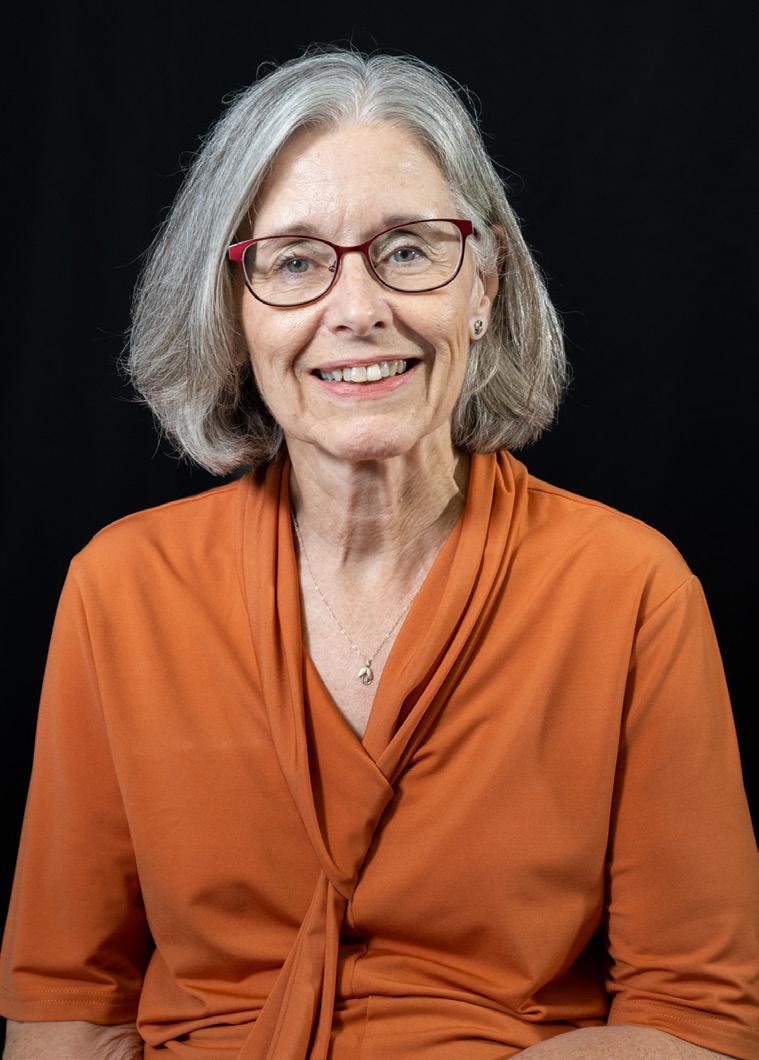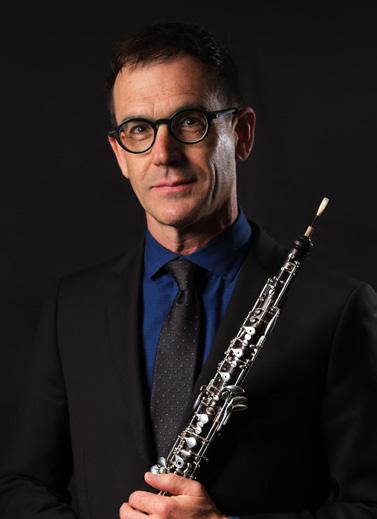Faculty Recital
I 7:30 pm Recital Hall

Wednesday I
Kyle Bruckmann, oboe and English horn Patricia Grimm, piano


October 19, 2022
13th Performance I 2022 23 Academic Year I Conservatory of Music I University of the Pacific
La peña y la luna I (2020)
I. La luna
II. La peña
Sonatina for Oboe and Piano (1955)
Allegretto
Canon: Lento Allegro non troppo Pietá (1950)
Hide Self, View (2021)
AT(ou)M (2020)
Chanson de fleurs: Eleanor of Aquitaine (2017)
La peña y la luna II (2020)
III. La luna II
IV. La peña II
Daniel Cueto ( b. 1986)
Grażyna Bacewicz (1909 1969)
Ulysses Kay (1917–1995)
Christopher Burns/Kyle Bruckmann (b. 1973/b. 1971) Jessie Cox (b. 1989) Dana Reason (b. 1976) Daniel Cueto (b. 1986)
PROGRAM I OCTOBER 19, 2022 I 7:30 PM
PROGRAM NOTES
Daniel Cueto: La peña y la luna
Born and raised in Lima to a Peruvian father and American mother, Daniel Cueto composes works reflective of his broad cultural experiences within European, North American, and South American music. His compositions have been described as “cleverly melding rich traditional Peruvian melodic and rhythmic elements with a contemporary flair, creating a personal style that is both pleasing and accessible to the listener and performer.”
Luna is the Spanish word for moon. A peña, in the context of Peruvian culture, is a venue where audiences gather to engage with and celebrate traditional music.
La peña y la luna consists of four miniature movements. The two “luna” movements are soulful, somewhat esoteric chants that showcase the oboe’ s uniquely rich and beautiful sound. The two “peña” movements are lively, exciting dances in the styles of two different genres of the Peruvian coast: the vals criollo (no. 2) and the marinera limeña (no. 4). The latter movement, specifically, opens with a quotation of the beginning of the second section of the track “Marineras en mayor” as recorded by the great Afro-Peruvian folklorist Nicomedes Santa Cruz on his album Socabón.
—adapted from danielcueto.com
Grażyna Bacewicz: Sonatina for Oboe and Piano
Through the fire of war and political oppression, Polish composer Grażyna Bacewicz composed more than 200 works of music. Critics of her time called her “the first lady of music.” She was a virtuosic violinist and pianist, author of murder mysteries, host of underground concerts during World War II, and a witty and indefatigable personality. She absorbed the influences of Neoclassicism, serialism, folk music, and the avant-garde, and forged her own distinctive style, inspiring a generation of Polish composers.
“For me the work of composing is like sculpting a stone, not like transmitting the sounds of imagination or inspiration. The majority of contemporary composers work as systematically as bureaucrats. If there is no inspiration one does the menial ‘workshop’ jobs, if there is inspiration the creative work continues. Discipline, strict discipline in composition is essential to for me. There is a saying: the house will fall down if it were to be built without principles. However, since dodecaphony does not appeal to me very much I am sitting alone and working out my own system” (Bacewicz, in a letter to Vytautas Bacevicius, October 23, 1958). adapted from Bard Music West and the Polish Music Center
PROGRAM NOTES
Ulysses Kay: Pietà
Ulysses Kay, the nephew of the classic jazz musician King Oliver, attended the University of Arizona, where he was encouraged by the African American composer William Grant Still. He went for graduate work to the Eastman School of Music in Rochester, New York, and there worked under Howard Hanson and Bernard Rogers. Kay met Paul Hindemith at the Berkshire Music Center and studied with him from 1941 to 1942.
After serving as United States Navy musician during World War II, Kay studied at Columbia University under Otto Luening and received several significant awards including the Alice M. Ditson Fellowship, a grant from the American Academy of Arts and Letters, and an award from the American Composers and American Broadcasting Company. He was the first African American to receive the Prix de Rome and wrote his eight-minute Pietà, a work for English horn and piano dedicated to Pietro Accoroni, in 1950 during his stay in the Eternal City, perhaps referring to Michelangelo’s sculpture.
Wise Music Classical
Christopher Burns/Kyle Bruckmann: Hide Self, View
On March 14, 2020, I met with the composer Amadeus Regucera for what, unbeknownst to us, was to become our last creative venture out in public for quite some time. He directed a deliriously weird video shoot, exploring sketches of ideas for what ultimately turned into Absence in Relief (2021), his multimedia composition for Splinter Reeds.
Fast forward through months of purgatory, to when bassist and composer James Ilgenfritz invited me to submit work to the second iteration of the Infrequent Seams Stream Fest. Already starting to sour on the desperate stopgap of solo performances clumsily livestreamed from home, I thought of my old friend and frequent collaborator Chris Burns, who had recently added to his evil-genius skillset (as a composer, guitarist, and electronic musician) some bracing work with algorithmically driven digital video editing. Amadeus graciously granted us free rein with the footage, and we giddily embarked on our long-distance mess-making, incorporating sounds of my oboe and analog synthesizers.
The resultant video premiered online on June 19, 2021. It’s meaningful to me to share it “live” in this program—many of us here survived together that surreal life trapped onscreen, with all of its glitching, dissociation, debilitating selfconsciousness, fractured attempts at communication, and frantic grasping towards human contact.
Kyle Bruckmann
PROGRAM NOTES
Jessie Cox: AT(ou)M
One of the world’s most brazenly experimental composers, Swiss artist Jessie Cox makes music about the universe—and our future in it. Through avant-garde, classical, experimental jazz, and sound art, he has devised his own strand of musical science fiction, one that asks where we go next. For the last decade, his music has been marked by its freeness; his embrace of otherness has led to a body of work described by the Los Angeles Times as “some of the most experimental music, not just of the day, but the season.”
Cox is influenced by a vast array of artists who have used their music to imagine futures, and he takes Afrofuturism as a core inspiration, asking questions about existence and the ways we make spaces habitable. Known for its disquieting tone and unexpected structural changes, his music steps into the unknown, and has been referred to by the New Yorker as an example of “dynamic pointillism,” a nebulous and ever-expanding sound world that includes “breathy instrumental noises, mournfully wailing glissandi, and climactic stampedes of frantic figuration.”
Fascinated with contingency, Cox comes at his compositions from a space of genuine curiosity. He doesn’t know what will happen to his music in a live setting—whether it will break down or continue to pulse—and seeks to pass the sensation along to his listener. “My teacher, Richard Carrick, once said about my music that he was always worried about whether it would survive for the whole performance,” Cox says, attempting to describe it. That is ultimately his aim: not to create something, but to search for it.
Robin Smith, for the Fromm Foundation
Dana Reason: Chanson de Fleurs: Eleanor of Aquitaine
Dana Reason is a composer, improvisor, keyboardist, sound artist, producer, and researcher, with a Ph.D. in critical studies and experimental practices from the University of California–San Diego. Her focus is on performance, improvisation, composition, scoring, and research in new and emergent musical fields.
As a performing artist working at the intersections of twentieth and twenty-first century musical genres and intermedia practices, she moves easily between genres encompassing a dynamic stylistic range and repertoire. She has been featured on more than seventeen commercially released recordings, including as a member of The Space Between Trio with American electronic arts pioneer Pauline Oliveros. She currently lives in Oregon, where she holds the position of assistant professor of contemporary music, School of Arts and Communication, at Oregon State University.
adapted from danareason.com
ARTIST BIOGRAPHIES
Kyle Bruckmann serves as the program director of chamber music and assistant professor of practice in oboe. Bruckmann earned undergraduate degrees in music and psychology at Rice University in Houston, studying oboe with Robert Atherholt, serving as music director of campus radio station KTRU, and achieving academic honor as a member of Phi Beta Kappa. He completed his Master of Music degree in 1996 at the University of Michigan, where he studied oboe performance with Harry Sargous and contemporary improvisation with Ed Sarath.
An electronic musician as well as an oboist, Bruckmann tramples genre boundaries in widely ranging work as a composer/performer, educator, and new music specialist. His creative output—extending from conservatory-trained foundations into gray areas encompassing free jazz, post-punk rock, and the noise underground—can be heard on more than 100 recordings. Three decades of chameleonic gigging have found him performing in settings including the Monterey Jazz Festival, the Venice Biennale, CBGB, Berghain, a twelve-foot diameter bomb shelter, and dangling thirty feet in the air by a harness from a crane.

Bruckmann’s current affiliations include Splinter Reeds, the San Francisco Contemporary Music Players, Quinteto Latino, Eco Ensemble, sfSound, and the Stockton Symphony. He has premiered dozens of works as a soloist and within these ensembles, working in particularly close collaboration with composers such as Olivia Block, Linda Bouchard, Gabriela Lena Frank, Michael Gordon, JoséLuis Hurtado, Maija Hynninen, Sky Macklay, Paula Matthusen, Myra Melford, Amadeus Regucera, Theresa Wong, and Eric Wubbels. Thanks to his uncommon distinction as an improvising oboist, he has performed and/or recorded with Creative Music progenitors Roscoe Mitchell, Anthony Braxton, and George Lewis, and has worked extensively for bandleaders such as Andrew Raffo Dewar and Lisa Mezzacappa.
Patricia Grimm currently serves as organist at Fremont Presbyterian Church in Sacramento. At the University of the Pacific she teaches sight singing and collaborative piano, and she serves as a collaborative pianist with students, faculty, and guest artists.
Grimm holds a Bachelor of Music degree in sacred music with organ concentration from Duquesne University, a Master of Music degree in choral conducting from Kent State University, and a Master of Music degree in collaborative piano from the Hartt School of Music. She also studied piano with Jonathan Feldman at the Juilliard School.

ARTIST BIOGRAPHIES
As a collaborative pianist, Grimm has performed at the Edinburgh International Music Festival in Edinburgh, Scotland; the Trinity Wall Street Music Series in New York City; and chamber music concerts at the Musica no Museu Festival of Winds, Museum of Modern Art, Rio de Janeiro, and Universidade Federal Do Estado Do Rio De Janeiro–Unirio, Rio de Janeiro, Brazil.
Grimm regularly performs throughout the United States as a collaborative pianist and chamber musician. Prior to moving to Sacramento in 2013, she was a freelance collaborative pianist in the New York City metropolitan area and staff accompanist at Central Connecticut State University, in addition to maintaining an active private teaching studio.
SUPPORT OUR STUDENTS AND PROGRAMS
Every gift to the Conservatory from an alumnus, parent, or friend makes an impact on our students. Our students rely on your generosity to enable them to experience a superior education.
Please contact the Assistant Dean for Development at 209.932.2978 to make a gift today. You may also send a check payable to University of the Pacific: Conservatory of Music, University of the Pacific Attn: Assistant Dean for Development 3601 Pacific Avenue Stockton, CA, 95211

UPCOMING CONSERVATORY EVENTS

Oct. 20 | 7:30 pm
Guest Artist Series Scott Holden, piano Recital Hall Oct. 21 | 12:30 pm
Conservatory Concert Hour Featuring conservatory students Faye Spanos Concert Hall
Oct. 23 | 9:15 am Pacific String Day Faye Spanos Concert Hall Oct. 23 | 2:30 pm
Friends of Chamber presents Cuarteto Latinoamericano Faye Spanos Consert Hall
music.pacific.edu







